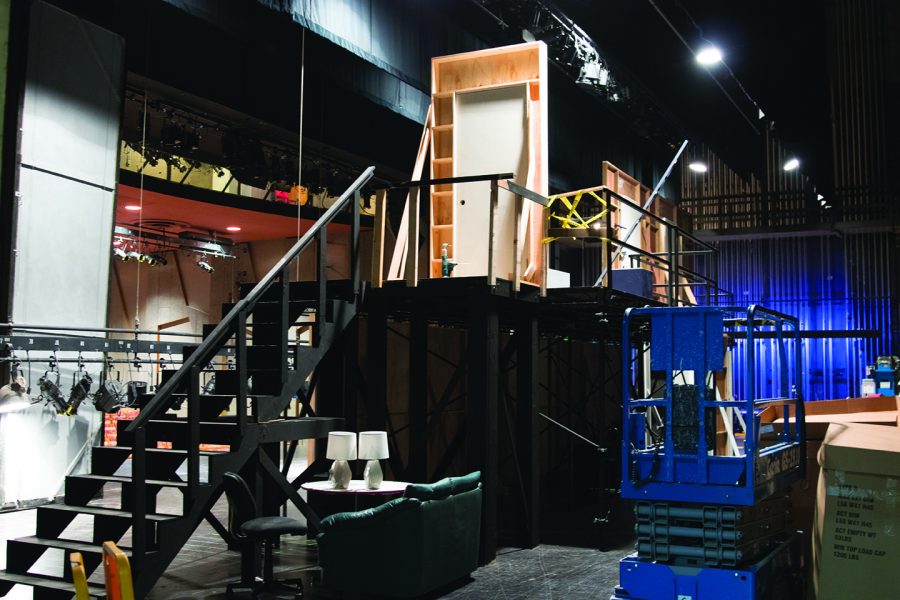After a much needed, year-long cosmetic surgery, the State Playhouse is back and looking sumptuous as ever. Fitted with what can be best described as a futuristic trim, the newly renovated playhouse heralds the theater scene on campus into the 21st century, with all the bells and whistles of a professional theater.
Erected in 1958 and left to stand until 2017, with a little more than a fresh coat of paint, these long overdue improvements—an exhaustive list—rescue the building from its formerly antiquated form. Indeed, visitors to the theater in the years before its renovation would have been greeted with an ambiance less theater and more museum.
“It’s always looked to me like a high school auditorium and now it feels like a theater—like real theater,” said Meredith Greenburg, Chair of the Theater Department. “The students who are working in there now are saying it feels different, like you sound different, because we’ve made it that way.”
The theater bears almost no resemblance to its previous state. The first thing one notices is the rearranged orchestra and an all-new box seat section.
“We have less seats than there were, which is actually a good thing. And we’re ADA compliant,” said Greenburg.
The long, sloping ramps—which were previously too steep for ADA guidelines—have been replaced with two separate levels, connected by a set of stairs. The front and back of the theater also provide wheelchair accessibility.
The seats themselves have been reupholstered, similar to that of the Ahmanson’s audience seating as well as the curtains which have been assigned a royal red or claret, to be precise.
Besides the interior furnishings, acoustic paneling has been applied to the walls to accompany the upgraded sound system. The lighting crew will also have their fair share of new accoutrement to work with—the cyclorama lights have been replaced with LED’s, obsoleting colored gels.
For the students in the Theater, Arts, and Dance program, the renovation is a breath of fresh air. It’s a confirmation that the university recognizes their craft and its importance in a wildly artistic landscape like Los Angeles.
So what does this mean for the future? Are these improvements a one-time deal or are they just the first in a series of investments to come?
“Boy, I hope so,” said Greenburg. “Certainly the people who gave the money have always been patrons of the theater and I think they walked in and thought, ‘God, how can we help you?’”
Whether or not the new State Playhouse is a harbinger of greater emphasis on the performing arts at Cal State LA, Greenburg sees numerous avenues for continued progress.
“The plan is to board up the box office where it is, turn it into offices or storage, and put the box office on the far side of the building with the window onto the campus so people actually see it’s a theater,” she said.
Previously, this was planned along with the Playhouse renovations, but the theater was left only enough funds for new lobby flooring.
In the meantime, Greenburg hopes more work can be done on the music hall and backstage areas.
Greenburg’s goal is to make the performing arts more accessible to the students and public. She wants the Playhouse visible on campus, and is doing all she can to encourage more students to see live theater. This year, she is even offering discounted ticket deals to introduction to higher ed courses and introductory theater classes.
At the same time, Greenburg is working to expand the technical design program. Students have taken the initiative to construct show sets, but this work has been done in the absence of a full-time technical faculty member.
Despite these being good times for the department, it is work being done to make up for the debilitating attrition the department has experienced. For the past eight years, the department has added no new faculty member to make up for its losses.
Two faculty searches are out, one for an Acting Instructor and another for a Design and Scenic Construction faculty member. Starting the Fall of 2019, two new theater professors will be welcomed into the department on tenure-track.
Though many in the department have lofty visions for the theater scene on campus, execution of these visions ultimately come down to funding. Even Greenburg has been cornered into catering to the STEM-oriented mindset of our university.
“The State Playhouse is the lab for the theater and music students. It is a laboratory space, just like a science lab,” she said. “The people who run this space, if they were in a science lab, would be sterilizing beakers, but instead they’re here maintaining the theater. Acting students, technical students, design students, deserve a place to work on the craft that they’re learning, and that’s what the theater here is.”
The State Playhouse plans to open its doors in mid-October, when the cast of We, the Invisibles breaks in the space. Tickets for this production can be found online by visiting the Department of Theater and Dance website.








